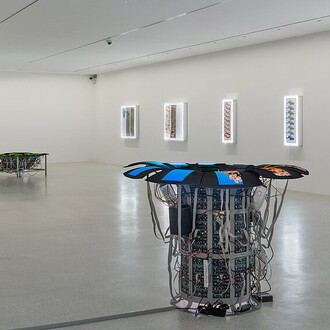In the exhibit Medien-ver-gleich, the artist Erik Swars (*1988) shows new works in diverse techniques.
Swars’ video work NTY (2Turner) depicts a sunset which illuminates an urban environment, framed by two skyscrapers, in spectrums of red and orange tones.
Stealthily, disenchantment creeps in, when the sun disappears and everything surrenders to a cool grey, the harbinger of the night. Only now, at the moment when the irretrievable experience is over, is one conscious of the beauty that arose from the impermanence of the moment. This sorrowful recognition is paired with the retrospective recollection of the natural spectacle and its imaginary reproduction in our thoughts and memories. Incidental noises such as the igniting of a lighter or techno music in the background open up associations to the context of the environment and allow individual narratives to emerge.
At the same time, the glowing red sky elicits an ambivalent game of sensations: Swars refers here, already in the title, to the British Romantic painter William Turner (1775–1851). His gleaming and radiant landscape paintings were created in the period after the dust from the volcanic eruption of Tambora in 1815 led to an intensification of red skies in the morning and evening. The violent discharge of a natural force caused an enhancement of the aesthetic and, completely in keeping with the Romantic movement, led to a subordination of the human individual in contrast to nature. It is also reminiscent of contemporary images: in this manner, pictures of wildfires, whose proportions are driven by climate change, contain ambivalent perceptions in themselves. From a purely aesthetic perspective, they are often reminiscent of sunsets and are formally powerful; in actuality, however, they are destructive and cost many living creatures their existence.
In Ohne Titel (last forever 1–3), Swars records shadows of plants on the image surface in differing intensity; sometimes hinted at as only a diffuse noise, sometimes as clear silhouettes of individual stems which spread out from a starting point and occasionally bend down from the burden of their own weight. In this manner the pictures function in a series like developing photographs, whose final pictorial development is not yet complete. The colouring and the reduced pictorial language open up associations with ancient pictures which, in cave paintings, exploited the principle of the contour in order, for example, to represent one’s own existence in the form of a hand. On the other hand, the pictures attain a forbidding, threatening effect due to the rustling and the seemingly toxic yellow. The pictures are therefore reminiscent of radiation catastrophes, by which the high level of radiation causes a noise in the images. In this context the pictures function like an attempt to conserve nature and to offer protection against the imminent global crisis.
Swars consistently transgresses the boundaries between photography, painting, and object. He therefore shows a portrait of the American singer Taylor Swift (*1989). She looks out of the picture in monochrome colours. It seems as if a power hidden behind the picture would push against the picture’s surface. The contours and the topography of the face appear to be pressed flat, and flatten out more and more into even, abstract surfaces. It remains a sensual yet at the same time disturbing portrait, bestowing a certain anonymity and autonomy to one of the figureheads of contemporary pop culture. Simultaneously, the homogeneous surfaces and the uniform proportions of the face are reminiscent of digital avatars which, on the one hand, can be used as parallel identities in the digital world and, on the other hand, after the most recent advances in artificial intelligence, serve as a personalisation of algorithms.
In Ohne Titel (Ponte San Moisé) Swars depicts a scene in Venice: people cross a bridge in both directions. A seemingly anonymous mass moves likes points in a system of coordinates, whose current position is clear and which disappears in the next moment. Connoisseurs of the art scene recognise, in the figure telephoning on the last step of the staircase, the influential curator Hans Ulrich Obrist (*1968). Swars plays with codes which purport a possible interpretation to those in the know: the significance of individual actors in the international art scene, who due to their decisions determine the canon of contemporary art. Without this context, the picture functions as a portrait of a city, one which is characterised by a rich history and which today has to struggle with ecological crises and mass tourism.
Swars’ works challenge the viewer to recalibrate strategies of perception and seeing, for the omnipresent images of our contemporary world. Also, in this way he always establishes connections between painting and photography, whose boundaries he constantly plumbs anew and observes from a variety of perspectives, so that changeable trajectories of reception can arise.
(Text by Leo Wedepohl, 2024, translation by Sarah Cormack)
















